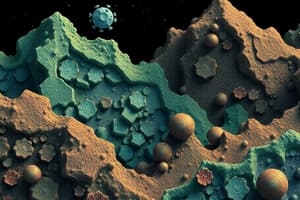Podcast
Questions and Answers
What is the size range of particles in a colloid?
What is the size range of particles in a colloid?
- Smaller than molecules
- Between 1-1000 nanometers in diameter (correct)
- Larger than what can be seen with the naked eye
- Exactly 1 micrometer in diameter
What is the term for the scattering of light by colloidal particles?
What is the term for the scattering of light by colloidal particles?
- Electrical Charge
- Brownian Motion
- Colloidal Dispersion
- Tyndall Effect (correct)
What type of colloid is whipped cream an example of?
What type of colloid is whipped cream an example of?
- Emulsion
- Foam (correct)
- Gel
- Sol
What is the characteristic of colloids that accounts for their heterogeneity?
What is the characteristic of colloids that accounts for their heterogeneity?
What type of colloid is ink an example of?
What type of colloid is ink an example of?
What is the term for the random movement of colloidal particles due to collisions with surrounding molecules?
What is the term for the random movement of colloidal particles due to collisions with surrounding molecules?
What is the characteristic of colloidal particles that affects their behavior and interactions?
What is the characteristic of colloidal particles that affects their behavior and interactions?
What type of colloid is mayonnaise an example of?
What type of colloid is mayonnaise an example of?
What is the term for the mixture of a substance consisting of microscopically dispersed insoluble particles distributed throughout another substance?
What is the term for the mixture of a substance consisting of microscopically dispersed insoluble particles distributed throughout another substance?
What type of colloid is fog an example of?
What type of colloid is fog an example of?
Flashcards are hidden until you start studying
Study Notes
Definition and Characteristics
- A colloid is a mixture in which one substance consists of microscopically dispersed insoluble particles that are distributed throughout another substance.
- The particles are larger than molecules but smaller than what can be seen with the naked eye (typically between 1-1000 nanometers in diameter).
- Colloids are heterogeneous, meaning they have different properties and compositions in different parts of the mixture.
Types of Colloids
- Sols: A colloid in which solid particles are dispersed in a liquid. Examples: ink, paint, and blood.
- Gels: A colloid in which a liquid is dispersed in a solid. Examples: jelly, gelatin, and agar agar.
- Foams: A colloid in which a gas is dispersed in a liquid. Examples: whipped cream, soap suds, and meringue.
- Emulsions: A colloid in which two or more liquids are dispersed in each other. Examples: mayonnaise, milk, and cream.
- Aerosols: A colloid in which a liquid or solid is dispersed in a gas. Examples: fog, haze, and mist.
Properties of Colloids
- Tyndall Effect: The scattering of light by colloidal particles, making them visible.
- Brownian Motion: The random movement of colloidal particles due to collisions with surrounding molecules.
- Electrical Charge: Colloidal particles can have an electrical charge, which affects their behavior and interactions.
Applications of Colloids
- Food Industry: Colloids are used in food products like mayonnaise, whipped cream, and ice cream.
- Pharmaceuticals: Colloids are used in medications and vaccines to improve delivery and absorption.
- Cosmetics: Colloids are used in personal care products like creams, lotions, and shampoos.
- Materials Science: Colloids are used in the development of new materials with unique properties.
Studying That Suits You
Use AI to generate personalized quizzes and flashcards to suit your learning preferences.



